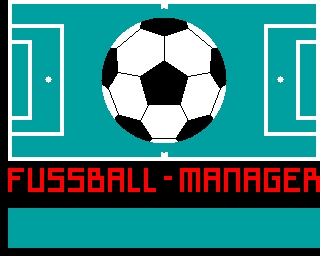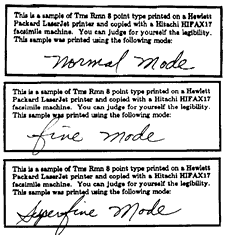CFOG's PIP, December 1988, Volume 7 No. 6, Whole No. 68, page 97
The Real FAX
by Benjamin H. Cohen
I disagree with Willis Cook wholeheartedly: FAX is great. In the old days when my law clients called me and asked to read aloud a three page contract, I refused and told them to send me a copy. But they wanted advice now, but I refuse to attempt to assimilate a three page document from one reading. (In one case I acceded to a client's request to read a Florida form lease over the telephone starting Friday evening at 6:00 p.m.; his Florida lawyer was out of town, he said, and he had to sign it the following morning, he said. After an hour and a half of reading and analyzing he took the lease to the Florida lawyer on Monday and amazed him with his paragraph by paragraph critique of the lease.) Now I just tell them: "FAX me a copy."
A few days ago a client called: he had just received a three page single-spaced letter from a court in Akron, Ohio. It should have been sent to our local lawyer in Cleveland. He didn't understand it. Instead of having to read it to me or a secretary who would have had to take it down in shorthand and transcribe it, he simply FAXed me a copy and I was immediately able to call Cleveland and fully inform the lawyer of the meaning of the communication.
I used to order office supplies from a catalog house by calling in orders. I wrote out a list and then someone spent time on the telephone reading the list to someone at the catalog house. Often the caller had to wait for an automatic system to get him an order taker. When mistakes were made we weren't sure whose mistake it was; did we read it wrong or did they write it down wrong. In any event we not only had to ship the stuff back and reorder, but we lost the time advantage of calling the order in rather than mailing it. Now we FAX the order in and mistakes are eliminated.
I think the problem is that Willis's fax machine is old. I remember the old days of fax: back in the days when the World Hockey Association was organized and the firm I was with was involved in some of the litigation. That's at least 15 years ago, probably more. A U.S. District Court in Boston issued an opinion in a related case. The litigation was all seeking injunctions, and of course we wanted a copy, as fast as possible. "Let us FAX it to you," they said. But the opinion was over 80 pages long, and group 1 FAX, the standard of the day, took six minutes a page (at optimum speed, something never attained over long transmissions in those days and not always now). We told them to run it out the Logan Field and put it on a plane: it would be a lot cheaper and be here sooner.
A few years later two officials of Viacom International inflicted a portable FAX on me. Viacom wanted to use my clients' home for a television series, "The American Dream". (Yeah, I know, you never heard of it. It was a mid-season replacement and was preempted three of the first five weeks it was scheduled to appear it never had a chance.) They were in a rush. Get the contract ready and we'll FAX it to the coast so the lawyers can get it approved right away. We sat there while they fiddled with the acoustic coupler, spent 45 minutes sending 12 pages to the coast, more time while they retransmitted two of the twelve pages, and then they informed us that the lawyers weren't available and we'd have to wait for a response (which came three days later).
But those were the old days. If they were still with us, the rush to FAX would not be occurring. The new machines are faster, more reliable, have better resolution, and are a lot cheaper. Like any technological wonder, they can be misused and abused. But I take issue with Willis Cook's FAX-bashing. Let's get specific.
Willis says in the old days he could call up John Smith for some data and John would read him the data, possibly calling back if he had to gather it first. Now Willis complains, he has to type up a list, FAX it over, and wait for the return FAX. That's misuse. If someone asked him to add up six numbers would he go to his computer, fire up SupcrCalc2, and print a spreadsheet on a laser printer? Or would he grab a printing calculator? And sometimes FAX is not the tool for transmitting information. So, Willis should just tell John Smith to read the list. If it's slower and less convenient to get small amounts of data by an exchange of FAX transmissions, Willis should shortcut the procedure.
But there are lots of cases in which it's better to use the FAX: one of the things I frequently do is real estate closings. In the old days we used to prepare the closing statement (with an adding machine as our only tool, if we had access to one). When it was all done we'd call up the other side and read the long list of numbers. "Tax proration, $1,347.56." "$1,437.65?" "No, $1,347.56." "Okay, got it." Fifteen minutes later a call would come back that there was some discrepancy, as often as not caused by a transposition or other mistake in the recording of the data at the other end. Now we prepare the closing statement on a SuperCalc2 spreadsheet, print it on a dot-matrix printer and FAX it to the other side along with copies of tax bills, loan payoff statements and other supporting documents. We don't spend anywhere as much time on the telephone and return calls are a rarity. When they do come it's not because of any mistake in transcribing the numbers at the other end.
One of my clients is an insurance broker. His clientele is nationwide. When he's not on the telephone he's not making money. I don't like terminal hold. When I want to make sure he gets the message I often punch it out on the computer, fax it to him, and wait for his response.
Willis doesn't seem to understand why a FAX cover sheet is needed to tell the recipient how many pages are coming. He wonders whether there's "some danger of several sheets getting lost in the electronic ether of the telephone network?" Well, while FAX transmissions are quite reliable, like everything else they are not without glitches. There are lots of machines without sheet feeders: to send multiple pages you have fifteen seconds after each page has been sent to get the next page in place and push a sequence of buttons. If you don't get it right, or if you're distracted at the crucial moment, the transmission stops and you have to dial again. (We sent that machine back and got one with an automatic feeder.) A sheet feeder can fail to send all the pages. The receiving machine will at some point run out of paper. Because of this it's nice to know whether there are more pages coming. It's especially important in organizations like Willis's to know whether all the pages have been received when the transmission ends. Should we bundle this package up and ship it off to Willis? Or are there three more pages that are still to come?
Willis talks about three minutes a page to transmit a FAX message. Well, I think it's about time that he tells the company to move into the '80s. I checked our logs: There's no transmission in either direction of a single page that's over 47 seconds. Any three minute transmissions involve at least seven pages. It's the newer 4800 bps and 9600 bps FAX modems that have made FAX popular.
Then there's the issue of legibility: Willis says the resolution is six dots per inch vertically "although it is better than that horizontally." Well, Willis, tell the company to get a modern FAX and turn back in the one that Alex Bell made in 1842. Most current FAX units have three settings: normal, fine, and superfine. Resolution for normal is 3.85 lines per mm, resolution for fine is 7.5 lines per mm, and resolution for superfine is 15.4 lines per mm. I won't attempt to convert that to dots per inch: the numbers aren't important. Now I'll admit that third generation copies of photographs don't come across too well, but even the fine print on Willis's wiring diagram should show up even without slowing down transmissions to superfine.
The important thing is in the reading. I've put three sample boxes of text at the end of this file. One is 'normal' FAX output, one is 'fine', and one is 'superfine'. The print is 8 point TmsRmn from a Hewlett Packard LaserJet. I've added a line of handwritten text indicating which is which. Judge for yourself.
We have a form FAX cover sheet generated on our laser printer. There's no point in putting it on expensive cotton content bond: the recipient won't get the sheet anyway. In fact, I print cover sheets combined with messages on my 9-pin dot-matrix printer all the time.


